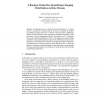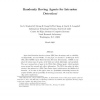106 search results - page 2 / 22 » Data Fusion and Cost Minimization for Intrusion Detection |
CCS
2008
ACM
13 years 9 months ago
2008
ACM
It is generally believed that by combining several diverse intrusion detectors (i.e., forming an IDS ensemble), we may achieve better performance. However, there has been very lit...
PKDD
2005
Springer
14 years 1 months ago
2005
Springer
In applications such as fraud and intrusion detection, it is of great interest to measure the evolving trends in the data. We consider the problem of quantifying changes between tw...
ACMSE
2005
ACM
14 years 1 months ago
2005
ACM
Accurate identification of misuse is a key factor in determining appropriate ways to protect systems. Modern intrusion detection systems often use alerts from different sources su...
NOMS
2010
IEEE
13 years 6 months ago
2010
IEEE
—Cooperation between intrusion detection systems (IDSs) allows collective information and experience from a network of IDSs to be shared to improve the accuracy of detection. A c...
DBSEC
2001
13 years 9 months ago
2001
Agent based intrusion detection systems IDS have advantages such as scalability, recon gurability, and survivability. In this paper, we introduce a mobile-agent based IDS, called ...


